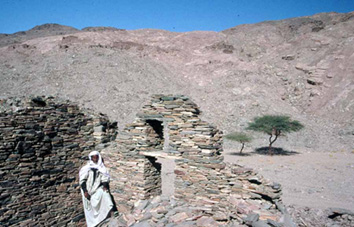Across the Egyptian Eastern Desert the remnants of thousands of years of human activity are visible. Well over 10.000 years ago, groups of hunters left their tools, graves and rock drawings in this region. During the Pharaonic period large expeditions were sent into this vast desert to mine gold, emeralds and amethysts and quarry granite, sandstone and calcite ("alabaster"). In the Greco-Roman period, the Eastern Desert became a crucial transit area for the long distance trade with Arabia, Africa and the Indian Ocean ports. In addition to important Red Sea emporia like Berenike, this period saw the building of a multitude of settlements, mining installations and temples. The extensive desert road system linking the Red Sea ports to the Nile demanded the construction of chains of road stations, wells and forts. By the 6th century AD most settlements and forts were abandoned.

a building in the Roman settlement of Nugrus
This small web-site is dedicated to the excavations in Sikait, the emerald mining centre of the ancient world.
Since 1994 an American-Dutch team is researching and describing the archaeological monuments in a large part of the Eastern Desert.